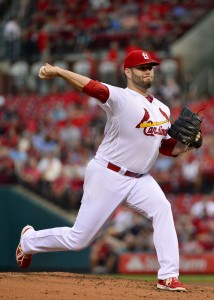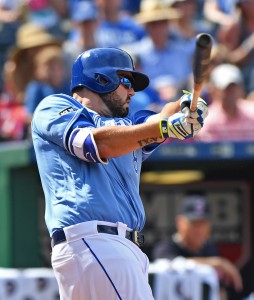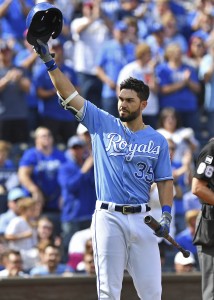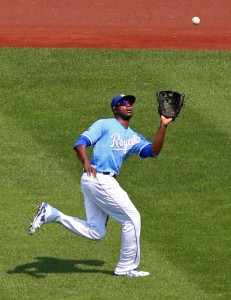After missing all of the 2016 season while recovering from Tommy John surgery, right-hander Greg Holland enjoyed somewhat of a bounceback 2017 while closing for the Rockies. After a 41-save campaign, he turned down both a player option and a qualifying offer in search of a more lucrative, multi-year pact.
Pros/Strengths
During Holland’s heyday with the Royals from 2012-2014, Craig Kimbrel and Aroldis Chapman were the only qualifying relievers with a better FIP than Holland’s 1.83. He also carried the majors’ 5th-highest strikeout rate (13.02 K/9) and ranked 2nd among relievers in Win Probability Added (8.38). I could list a hailstorm of other statistics that prove Holland’s dominance, but the above rankings should paint a clear enough picture: he was long one of the game’s preeminent closers. That experience in high leverage situations may also prove a plus, including the seven late-inning leads he converted to saves during the 2014 postseason.
Even during an up-and-down 2017 season, Holland managed to strike out 10.99 batters per nine innings. While that’s not quite to the elite level he achieved during the window mentioned above, it’s still earned him a spot in MLB’s top-30 relievers in that regard. There’s no reason to expect he won’t continue to rack up the K’s.
Among the Colorado free agent’s pitch arsenal is an absolutely lethal slider. He threw the pitch even more often than his fastball in 2017, and with great results; opposing hitters managed a wRC+ of just 10 in plate appearances ending with that pitch. Fangraphs’ pitch value estimators suggest that Holland’s slider was worth 2.77 runs per 100 uses. The opposition hit just .139/.173/.230 against it while striking out a whopping 58 times.
Cons/Weaknesses
The most prominent risk to signing Holland is that he’s no sure bet to stay healthy. While he proved durable during his peak with the Royals, his 2015 campaign began with an April DL stint due to a pectoral strain, and ended with a UCL tear in September. Holland managed to stay healthy for a vast majority of the 2017 season, but his peripheral stats overall weren’t indicative of the dominance he boasted during his healthy years. While some may point may point to the fact that he played his home games in Coors Field, his ERA in away games was actually higher than it was in Denver.
Even if he can avoid the disabled list, Holland is three years removed from elite reliever status. Yes, he collected 41 saves last season, but his overall performance on the mound was decidedly average. That’s not hyperbole; out of 155 qualified relievers in 2017, Holland ranked middle-of-the-pack in ERA (87th), FIP (76th) and xFIP (86th). Judging by reports that he turned down a strong offer from the Rockies already this winter, it’s fair to infer that the 32-year-old wants to be paid in part for his past reputation, which he’s far from a lock to live up to given that it’s quite distant in the rearview mirror, and that his average fastball last season was nearly 3 MPH lower than it was over the course of the 2014 campaign .
There’s another glaring weakness worth noting… Holland has struggled mightily with control in each of his last two seasons. His BB/9 marks were 5.24 and 4.08 in 2015 and 2017, respectively. It’s not the first time he’s had walk issues, either; the righty’s 2012 campaign was stained by a 4.57 BB/9 as well. It’s fair to be skeptical about whether he’ll be able to hold ninth-inning leads if he can’t control the free passes. One additional fun fact: batters who are able to work a 3-0 count on Holland have reached base over 84% of the time over the course of his career.
Background
The Royals selected Gregory Scott Holland out of West Carolina University in the 10th round of the 2007 draft. He was utilized as a reliever from the get-go, and made his major league debut with a one-inning appearance in 2010.
It didn’t take him long to make an impact. Holland posted fantastic results out of Kansas City’s bullpen from April 2011 through July 2012, prompting the Royals to make him their closer following a midseason trade of Jonathan Broxton to the Reds. As discussed above, he enjoyed a lengthy run as one of the top relievers in the game up through the 2014 playoffs, during which he led a late-inning trio of Royals relievers (which also included Wade Davis and Kelvin Herrera) that proved one of the most formidable of all time.
Market
At the outset of the 2017-2018 offseason, MLBTR ranked Holland as the 10th-best free agent available on our list of the winter’s top 50. He’s now one of just two relievers remaining on that list (#44 Tony Watson is the other), including the honorable mentions. To see him still available in January of an offseason where relievers have flown off the shelves at unexpectedly high prices is somewhat surprising, although his agent Scott Boras has certainly been patient in the past.
There’s no denying that said patience has paid off more than once. One need not look any further than Prince Fielder and Max Scherzer for examples of Boras clients who’ve signed lucrative deals in late January. That being said, Holland seems to be in a very unfavorable position at present. The Cardinals, who were thought to be one of his chief suitors back in November (and our predicted destination for the righty), pivoted to Luke Gregerson; while they are still a potential landing spot for a closer, the team is said to have “at most, tempered” interest in Holland. The Rockies, too, are seemingly no longer a realistic landing spot for him following their signings of Jake McGee, Bryan Shaw and Davis to three-year guarantees. Typically high-spending teams like the Dodgers, Yankees and Giants now sit quite close to the luxury tax threshold and seem determined to remain beneath it for 2018, while the Red Sox are already above that $197MM figure headed into 2018. Given that those organizations already control top-end closers, they aren’t likely to splurge on Holland. The Nationals, too, are already in a position to exceed that ceiling due to complexities in the tax rules; more importantly, in that case, the team likely feels comfortable with its existing late-inning mix.
Of course, that doesn’t mean there aren’t still practical fits for Holland. The Astros, Cubs, Rangers and Brewers stand out as potential contenders with both a clear need for a reliever and the capacity to add some payroll (indeed, the Astros in particular are said to be looking for a high-leverage arm). But judging by the lack of rumors surrounding Holland over the past month or so, it’s fair to wonder whether he’s engaged in a metaphorical staring contest with one or more teams in relation to the type of contract he’s seeking.
Expected Contract
It’s been reported that Holland began the offseason seeking a five-year deal, which seemed unlikely from the start and is even harder to imagine now. Frankly, it would be quite a shock if Boras was able to find Holland a deal of that length at this point; such a contract would last through his age-37 season and has significant downside considering the health and durability concerns stemming from his 2015 elbow surgery and up-and-down second half in 2017, respectively. At the same time, Holland was able to prove that he’s still a talented strikeout artist, even if he hasn’t bounced back quite to his pre-injury capability in that regard. Considering that even Wade Davis, a superior option, ended up settling for three years, I think Holland’s likely to end up doing the same. A three-year contract with a $39MM guarantee seems like a plausible estimate at this point in the offseason, but I wouldn’t be surprised if he ends up with some performance incentives or a Shaw-esque vesting option for a fourth season.






